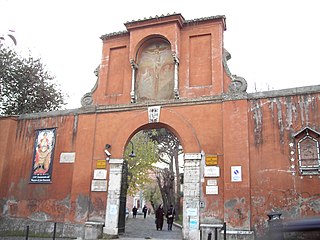
Giovanni Battista (Carlo) de Rossi was an Italian archaeologist, famous even outside his field for rediscovering early Christian catacombs.

Santi Nereo ed Achilleo is a fourth-century basilica church in Rome, Italy, located in via delle Terme di Caracalla in the rione Celio facing the main entrance to the Baths of Caracalla. It has been the titular church of Cardinal Celestino Aós Braco since 28 November 2020. Unusually it is part of a detached portion of the parish of Chiesa Nuova rather than the local geographical parish of San Saba and is served by Oratorians as a satellite of the Roman Oratory.
Antonio Bosio was a Maltese scholar, the first systematic explorer of subterranean Rome, author of Roma Sotterranea and first urban spelunker.

The basilica of San Pancrazio is a Catholic minor basilica and titular, conventual, and parish church founded by Pope Symmachus in the 6th century in Rome, Italy. It stands in via S. Pancrazio, westward beyond the Porta San Pancrazio that opens in a stretch of the Aurelian Wall on the Janiculum and covers the Catacomb of San Pancrazio. The adjacent convent was established perhaps as early as the church and has been occupied by the Discalced Carmelite since 1662.

Santi Marcellino e Pietro al Laterano is a Roman catholic parish and titular church in Rome on the Via Merulana. One of the oldest churches in Rome, it is dedicated to Saints Marcellinus and Peter, 4th century Roman martyrs, whose relics were brought here in 1256.

Francesco Mancini was an Italian painter whose works are known between 1719 and 1756. He was the pupil of Carlo Cignani.

The Catacomb of Generosa is a catacomb of Rome (Italy), located in Via delle Catacombe di Generosa, close to a big bight of river Tiber on the right bank, in the Portuense quarter.

The Catacomb of Saint Agnes is one of the catacombs of Rome, placed at the second mile of via Nomentana, inside the monumental complex of Sant'Agnese fuori le mura, in the Quartiere Trieste.

The Catacomb of San Pancrazio is a catacomb of Rome (Italy), located in the Via Aurelia, within the modern Quartiere Gianicolense.

The Catacombs of Saint Gaudiosus are underground paleo-Christian burial sites, located in the northern area of the city of Naples.
The Hypogeum of Vibia is part of a small complex of pagan burial chambers in Rome which were constructed along the Via Appia in the late 4th century CE. It is named for the burials of a woman named Vibia and her husband Vincentius, a priest of the Thraco-Phrygian god Sabazios. The hypogeum is notable for the paintings that show the deceased figures in mythological scenes and in the underworld, and for their accompanying inscriptions. Numerous other decorated tombs and inscriptions were found in the complex.
The Catacomb of Sant' Ermete or Catacomb of Bassilla is a catacomb on the former via Salaria in Rome, now sited in the Pinciano district on via Berolini. It originated some time between 200 and 250.

The Catacomb of Santi Marco e Marcelliano is a catacomb between the ancient via Appia antica and via Ardeatina in what is now the Ardeatino district of Rome. With the catacomb of Callixtus and the Catacomb of Balbina, it is one of three catacombs in the Callixtian Complex between the via Appia antica, via Ardeatina and vicolo delle Sette Chiese.
The Catacomb of Saints Processus and Martinianus is one of the catacombs of Rome. Sited on the via Aurelia, no ancient remains have been conclusively identified as being it.
The Via Dino Compagni Hypogeum or Via Latina Catacomb is an underground cemetery on via Dino Compagni in Rome, near via Latina, in the Appio-Latino quartiere. Built in late antiquity but appearing in no ancient sources, it is now privately-run.

The Catacomb of Sant'Ippolito is a catacomb on the via Tiburtina in Rome, now entered from via dei Canneti in the modern Nomentano quartiere.
The Catacombs of Santa Felicita or Catacomb of Maximus is a three-level complex of catacombs on the modern via Salaria in the modern Salario quarter of Rome. In the 17th century it was also known as the Catacomb of Sant'Antonio after the patron saint of the Vienne monastery which owned the land in which it fell.
The Catacomb of San Panfilo is one of the catacombs of Rome, sited under via Paisiello and via Spontini in the Pinciano quarter and along the line of the ancient route of the via Salaria. It is named after the Carthaginian martyr Pamphilus. The modern-day entrance is in Santa Teresa del Bambin Gesù in Panfilo. The ancient sources identify it as the first catacomb on the via Salaria starting from porta Pinciana.

The Annunziatella is a Roman Catholic church in the Ardeatino quarter of Rome between via Ardeatina and via di Grotta Perfetta. Beneath it is the Catacomb of the Nunziatella.

The Catacomb of San Nicomede was a catacomb at the start of the via Nomentana near the modern Porta Pia in the Nomentano quarter, though its precise location is still unknown.













